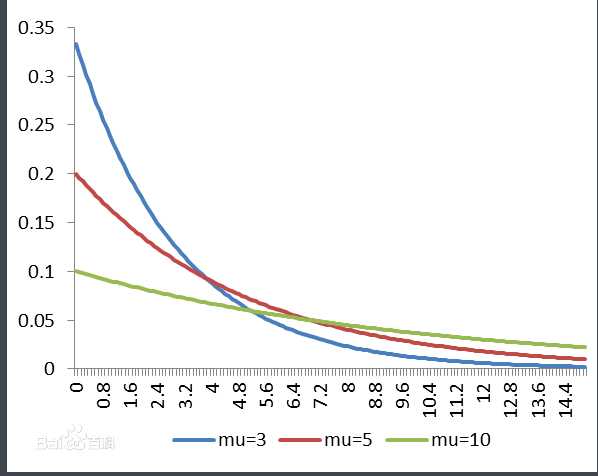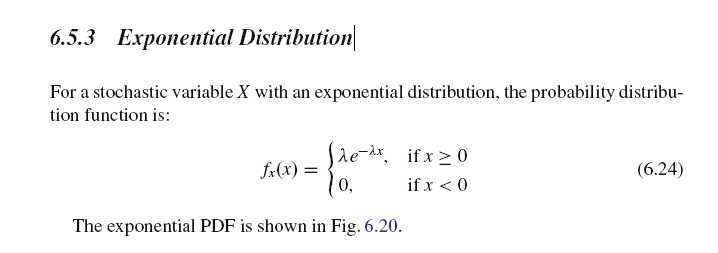指数分布和泊松过程(Exponential Distribution and Poisson Process)--2(指数分布的例题)
Posted siranlee
tags:
篇首语:本文由小常识网(cha138.com)小编为大家整理,主要介绍了指数分布和泊松过程(Exponential Distribution and Poisson Process)--2(指数分布的例题)相关的知识,希望对你有一定的参考价值。
例 1
Suppose that customers are in line to receive service that is provided sequentially by a server; whenever a service is completed, the next person in line enters the service facility. However, each waiting customer will only wait an exponentially distributed time with rate \\(θ\\); if its service has not yet begun by this time then it will immediately depart the system. These exponential times, one for each waiting customer, are independent. In addition, the service times are independent exponential random variables with rate \\(\\mu\\). Suppose that someone is presently being served and consider the person who is \\(n_th\\) in line.
(a) Find \\(P_n\\), the probability that this customer is eventually served.
(b) Find \\(W_n\\), the conditional expected amount of time this person spends waiting in
line given that she is eventually served.
我们手头有的信息是每一个顾客都有一个等待时间,而这个等待时间对每一个顾客都是一个参数为\\(\\theta\\)的相互独立的指数随机变量,当过了某个顾客的等待时间而这个顾客的服务还没开始,那么这个顾客就会立即离开队伍。另外还知道的是服务时间是参数为\\(\\mu\\)的指数随机变量。
问题a需要我们求第\\(n\\)个顾客最终接受服务的概率\\(P_n\\), 目标事件是这第\\(n\\)个顾客最终接受服务,而需要目标事件发生就需要前\\(n-1\\)个顾客耽搁的总时间不能超过第\\(n\\)个顾客的等待时间,也就是说第\\(n\\)个顾客的等待时间应该要比前面\\(n-1\\)个顾客耽搁的时间以及正在接受服务的那个人的剩余服务时间长。
现在将队伍中包括第\\(n\\)个人在内的\\(n\\)位顾客的等待时间以及正在接受服务的那位顾客的剩余服务时间看作\\(n+1\\)个独立的指数随机变量,根据上面的说法,如果第\\(n\\)个顾客的等待时间是这\\(n+1\\)个随机变量中的最小值,那么他将在正在接受服务的顾客接受服务时离开而不会接受到他的服务;另一方面,如果第\\(n\\)个的等待时间不是最小的,也就是说在他离开之前,队伍里或者接受服务的人离开了,此时他变为了队伍里第\\(n-1\\)个人,此时他(第\\(n-1\\)个人)接受服务的概率就相当于开始时他在第\\(n-1\\)个位置上一样(指数分布的无记忆性)。
那么根据上面的表述有:
\\(\\beginalign*P_n = &P\\第n个人接受服务|第n个人的等待时间是最小值\\P\\第n个人的等待时间是最小值\\\\\\ &+P\\第n个人接受服务|第n个人的等待时间不是最小的\\P\\第n个人的等待时间不是最小的\\\\endalign*\\)
其中容易看出第一项为0,而\\(P\\第n个人的等待时间不是最小的\\ = 1-P\\第n个人的等待时间是最小的\\\\),而后一个概率对应于事件\\(X_i=\\min_j X_j\\), 那么有
\\(P\\第n个人的等待时间不是最小的\\ = 1-\\frac\\thetan\\theta+\\mu=\\frac(n-1)\\theta+\\mun\\theta+\\mu\\)
所以有
\\(P_n = \\frac(n-1)\\theta+\\mun\\theta+\\mu P_n-1\\)
进一步迭代这个式子给出
\\(P_n = \\frac\\theta+\\mun\\theta+\\muP_1 = \\frac\\theta+\\mun\\theta+\\mu \\frac(1-1)\\theta+\\mu\\theta+\\mu = \\frac\\mun\\theta+\\mu\\)
例2
Let \\(X_1,X_2,\\cdots,X_m\\) be independent exponential random variables with respective rates \\(\\lambda_1,\\cdots,\\lambda_m\\), where \\(\\lambda_i\\neq \\lambda_j\\) when \\(i\\neq j\\). Let \\(N\\) be independent of these random variables and suppose that \\(\\sum_n = 1^m P_n = 1\\) where \\(P_n = P\\N =n\\\\). The random variable \\(Y = \\sum_j = 1^N X_j\\) is said to be a Coxian random variable. How is the probability density of Coxian random variable?
通过对\\(N\\)取条件可以得出
\\(f_Y(t) = \\sum_n = 1^m f_Y(t|N=n)P_n = \\sum_n = 1^m P_n f_X_1+X_2+\\cdots+X_n(t)\\)
其中\\(f_X_1+X_2+\\cdots+X_n(t)\\)就是\\(n\\)个独立的不同随机变量的和的密度函数。
PS: Cox 随机变量一般以以下形式出现:假设一个部件必须经过\\(m\\)个时间段的处理才能修复,每一个时间段都有一个概率\\(P_k\\)使得该部件离开这个程序,如果假设部件通过相继的时间段的时间是指数随机变量,那么一个部件花费在这个程序中的总时间是一个Cox随机变量
Exponential Distribution指数分布
医药统计项目合作请联系
QQ:231469242
http://baike.baidu.com/item/%E6%8C%87%E6%95%B0%E5%88%86%E5%B8%83?sefr=cr

指数函数的一个重要特征是无记忆性(Memoryless Property,又称遗失记忆性)。这表示如果一个随机变量呈指数分布,当s,t>0时有P(T>t+s|T>t)=P(T>s)。即,如果T是某一元件的寿命,已知元件使用了t小时,它总共使用至少s+t小时的条件概率,与从开始使用时算起它使用至少s小时的概率相等。

记号
特性
编辑无记忆性
分位数
分布
应用
编辑
以上是关于指数分布和泊松过程(Exponential Distribution and Poisson Process)--2(指数分布的例题)的主要内容,如果未能解决你的问题,请参考以下文章
R可视化绘制指数分布(Exponential Distribution)
指数族分布(Exponential Families of Distributions)
R语言指数分布(exponential distribution)函数(dexp, pexp, qexp & rexp)实战